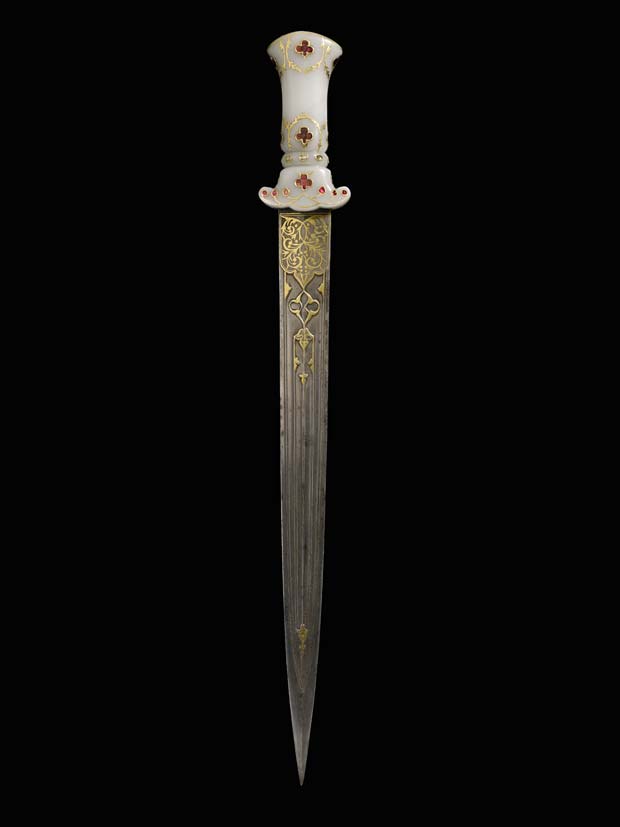FWP:
SETS == A,B
JIGAR: {2,1}
SWORD: {1,3}
VEIL: {6,1}
SCRIPT EFFECTS: {33,7}
The commentators point out the clever visual 'letter-play' with the dagger-like alif , between niyām (spelled 'n-y-a-m'), the 'sheath' from which the alif-dagger is to be pulled out, and nīm (spelled 'n-y-m'), the 'half' and sidelong glance that results. Nazm's complaint that this supererogatory wordplay 'murders the meaning' is merely persnickety; the wordplay is enjoyable in itself, and it's not obliged also to work on every possible semantic level. As Nazm himself points out, the range of possible interpretations is very broad in any case.
Bekhud Mohani points out that the word adā constitutes an īhām . What this means is that in the context of 'sidelong glance,' we think of adā karnā in its sense of 'to coquet', to display flirtatious airs and graces. Only in retrospect does it become clear that adā karnā meaning 'to perform' is what is required for the meaning of the verse (see the definitions above). This is a classic form of īhām : a misdirection that requires the hearer to backtrack and reinterpret on the fly; in the present case, it also leaves an enjoyable touch of the earlier meaning hovering above the verse. The īhām loses some of its effectiveness, however, because the information needed for the correct reading is provided at once, right after the misdirection has occurred, so the hearer hardly has time to establish the misreading before it's instantly changed into the right one. If the correction had been provided only after a delay-- ideally, late in the second line-- then the enjoyment would have been considerably greater.
To the set of nīm-ġhamzah , adā , and nāz in the first line is juxtaposed pardah in the second line: the beloved's coquettish behavior implies a clever use of concealment or avoidance, alternated with blandishments. The image of the beloved's sidelong glance, or a glance from behind a (literal or metaphorical) pardah , 'veil, curtain', is a perfect example of such coquetry. This coquetry is a 'trust' that has been placed in the beloved's custody (by God? by the lover?), so it's positively the beloved's duty to maintain and display it. Drawing out the dagger from the pardah or seclusion of the lover's liver, and letting it flash coquettishly in full daylight, is surely no more than proper behavior on the beloved's part.
Not surprisingly, the commentators disagree on what it means to pull the dagger from the sheath of the pardah of the liver. (For more on the implications of jigar , see {30,2}.) It could mean: (1) draw the dagger out, to use it for coquetry, from the liver-sheath in which you store it (Nazm); (2) slow the dying of the wounded lover by drawing out the dagger (Bekhud Dihlavi); (3) kill the dying lover quickly by drawing out the dagger (Baqir). There's undoubtedly a connection between the beloved's coquetry and the use of the lover's liver as a sheath for the beloved's dagger-- but it's left up to us to decide what that connection is.
Note for grammar fans: The ambiguity of the 'A,B' structure is increased by the double possibilities of
the two verbs kar and kheñch
. Both of these can be read as intimate imperatives, thus yielding two independent
lines. Or they can be read as kar ke and kheñch
, such that the action of the first line precedes that of the second;
or else they can be read as kar and kheñch kar
, such that the action of the second line precedes that of the first. (They
can't both be read as kar -deletion cases, however,
since then we'd lack a finite verb.)

Nazm:
If the dagger-- that is, alif [a straight vertical line]-- is removed from niyām ['sheath'], then it becomes nīm ['half'], but this dagger has also murdered the meaning. The field of interpretation is very broad. If he has put a meaning in it, it is this: that your airs and graces are a Divine trust; in order to do them justice, show your coquetry, and thus grasp the dagger, so that it can be recognized. Being drawn out, it emerges from the veil of the lover's liver. That is, coquetry is a sword without a sheath; if it has a sheath, then it's the wound in the lover's liver. (51)
== Nazm page 51